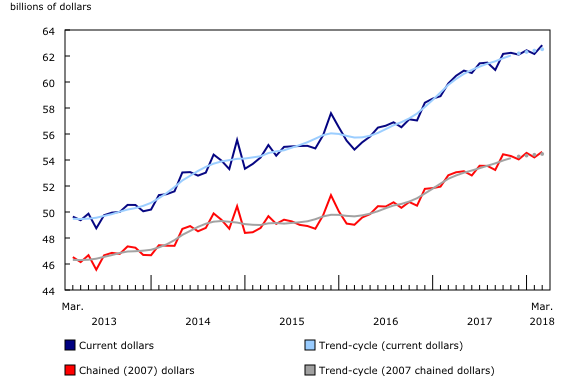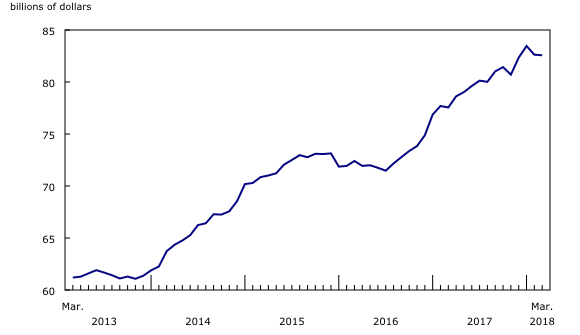Wholesale trade, March 2018
Archived Content
Information identified as archived is provided for reference, research or recordkeeping purposes. It is not subject to the Government of Canada Web Standards and has not been altered or updated since it was archived. Please "contact us" to request a format other than those available.
Released: 2018-05-22
$62.8 billion
March 2018
1.1% 
(monthly change)
$334.7 million
March 2018
-5.0% 
(monthly change)
$70.9 million
March 2018
-4.9% 
(monthly change)
$832.5 million
March 2018
-0.6% 
(monthly change)
$547.7 million
March 2018
-0.7% 
(monthly change)
$11,222.0 million
March 2018
-0.6% 
(monthly change)
$32,798.3 million
March 2018
2.5% 
(monthly change)
$1,621.3 million
March 2018
-0.4% 
(monthly change)
$2,091.8 million
March 2018
2.5% 
(monthly change)
$6,743.8 million
March 2018
-0.7% 
(monthly change)
$6,496.2 million
March 2018
-0.1% 
(monthly change)
$9.9 million
March 2018
13.0% 
(monthly change)
$54.3 million
March 2018
-2.8% 
(monthly change)
$11.1 million
March 2018
-21.3% 
(monthly change)
Wholesale sales rose 1.1% to $62.8 billion in March, more than offsetting the decline in February. The motor vehicle and parts subsector contributed the most to the gain. Excluding this subsector, wholesale sales rose 0.2%.
Sales were up in four of seven subsectors in March. In volume terms, wholesale sales rose 0.8%.
In the first quarter of 2018, wholesale sales rose 0.5% in current dollars and 0.4% in constant dollars compared with the fourth quarter of 2017. For both current and constant dollars, this marked the eighth consecutive quarterly increase
Higher sales in four subsectors
The motor vehicle and parts subsector recorded the largest gain in dollar terms, with sales rising 5.0% to $11.8 billion, following three consecutive monthly declines. Lower sales in the other two industries within the subsector were outweighed by gains in the motor vehicle industry (+6.6%), where sales rose following five consecutive monthly declines. This was the highest sales level since the record high in September 2017 for both the subsector and the industry. Imports of passenger cars and light trucks were up in both February and March.
Sales in the building material and supplies subsector increased 3.4% to a record high $9.2 billion. Sales were up in every industry, led by the metal service centres industry (+9.4% to $1.9 billion). Related indicators including imports of metal and non-metallic mineral products and the Industrial Product Price Index for primary ferrous metal products and primary non-ferrous metal products also increased in March.
The personal and household goods subsector rose 0.6% to $8.8 billion. Gains in the pharmaceuticals and pharmacy supplies industry (+3.6%) offset declines in other industries.
Sales in the food, beverage and tobacco subsector declined for the second consecutive month, down 1.4% to $11.9 billion in March. The food products industry (-1.5%) accounted for most of the decline in the subsector.
Sales in the machinery, equipment and supplies subsector fell for the second time in three months, down 0.5% to $12.6 billion in March. The computer and communications equipment and supplies (-3.2%) and the construction, forestry, mining, and industrial machinery, equipment and supplies (-2.5%) industries led the declines.
On a quarterly basis, the food, beverage and tobacco (+2.0%) and the machinery, equipment and supplies (+1.8%) subsectors led the gain in the first quarter of 2018, their second consecutive quarterly gain. The gains in these subsectors were attributable to record high sales in January (food) and February (machinery).
Sales up in two provinces, led by Ontario
Sales were up in two provinces in March, which together accounted for 56% of wholesale sales in Canada. In dollar terms, Ontario contributed the most to the gains.
Sales in Ontario rose 2.5% to $32.8 billion in March, on the strength of higher sales in four of seven subsectors. This was the largest monthly increase for the province since January 2017. The motor vehicle and parts subsector (+7.7%) contributed the most to the gain, following five consecutive monthly declines. The building material and supplies subsector (+8.0%) also contributed to higher sales in Ontario with its second consecutive monthly gain.
In Saskatchewan, sales increased for the first time in five months, up 2.5% to $2.1 billion, on the strength of higher sales in three subsectors. The gain was led by higher sales in the miscellaneous subsector (+11.6%), following a 12.1% decline in February. The agricultural supplies industry contributed the most to the gains in the miscellaneous subsector.
Sales were down in Quebec for the fourth time in five months, declining 0.6% to $11.2 billion. Lower sales in the food, beverage and tobacco (-6.2%) and the building material and supplies (-2.5%) subsectors contributed the most to the decline. The food, beverage and tobacco subsector declined for the first time in 2018, while the building, material and supplies subsector decreased for the second time in three months. Despite the decline in March, sales in Quebec were up 0.1% in the first quarter of 2018, their eighth consecutive quarterly increase.
Following three consecutive gains, sales in Alberta declined 0.7% to $6.7 billion in March, led by the machinery, equipment and supplies subsector (-2.6%). This subsector has declined 4.5% in value over the past two months.
Inventories edge down in March
Wholesale inventories edged down 0.1% in March to $82.6 billion. Decreases in three subsectors, representing 32% of total wholesale inventories, were offset by gains in three other subsectors.
Inventories in the motor vehicle and parts subsector decreased 1.3% in March, accounting for the largest drop in dollar terms. The motor vehicle industry (-3.0%) was the sole contributor to the decline.
The personal and household goods subsector (-0.6%) decreased for the first time in 2018. Lower inventory levels in the personal goods industry (-6.1%) contributed the most to the drop.
Higher inventories in the building material and supplies subsector (+0.8%) were led by higher stock levels in the metal service centres industry (+4.6%).
Inventories in the miscellaneous subsector (+0.5%) rose for the fourth time in five months, led by the recyclable material (+16.0%) and agricultural supplies (+1.0%) industries.
The inventory-to-sales ratio decreased from 1.33 in February to 1.31 in March. This ratio is a measure of the time in months required to exhaust inventories if sales were to remain at their current level.
Note to readers
This release incorporates annual revisions. Unadjusted monthly wholesale data were revised back to January 2012, while seasonally adjusted data were revised back to January 2009. Factors influencing revisions include the late receipt of respondent information, the correction of information in the data provided, the replacement of estimated figures with actual values (once available), the re-classification of companies within, into and out of the wholesale trade sector and updates to seasonal factors.
Data in volume terms were also revised back to January 2009.
The data have been revised using historical linkage factors designed to preserve the continuity of the time series. The linkage method leads to larger revisions for more recent periods.
All data in this release are seasonally adjusted and expressed in current dollars, unless otherwise noted. For information on seasonal adjustment, see Seasonally adjusted data – Frequently asked questions.
Total wholesale sales expressed in volume are calculated by deflating current dollar values using relevant price indexes. The wholesale sales series in chained (2007) dollars is a chained Fisher volume index with 2007 as the reference year. For more information, see Sales in volume for Wholesale Trade.
The Monthly Wholesale Trade Survey covers all industries within the wholesale trade sector as defined by the North American Industry Classification System (NAICS), with the exception of oilseed and grain merchant wholesalers (NAICS 41112), petroleum and petroleum products merchant wholesalers (NAICS 412) and business-to-business electronic markets, and agents and brokers (NAICS 419).
For information on trend-cycle data, see the StatCan Blog and Trend-cycle estimates – Frequently asked questions.
Real-time CANSIM tables
Real-time CANSIM tables 081-8011, 081-8012 and 081-8015 will be updated on June 4. For more information, consult the document Real-time CANSIM tables.
Next release
Wholesale trade data for April will be released on June 21.
Contact information
For more information, contact us (toll-free 1-800-263-1136; 514-283-8300; STATCAN.infostats-infostats.STATCAN@canada.ca). For analytical information, or to enquire about the concepts, methods or data quality of this release, contact John Burton (613-862-4878; john.burton@canada.ca), Manufacturing and Wholesale Trade Division.
- Date modified:



